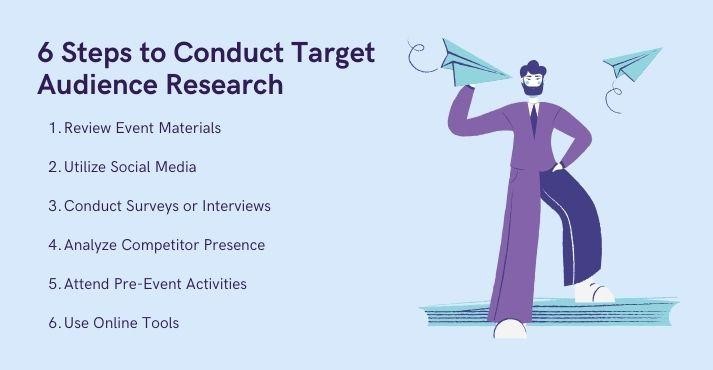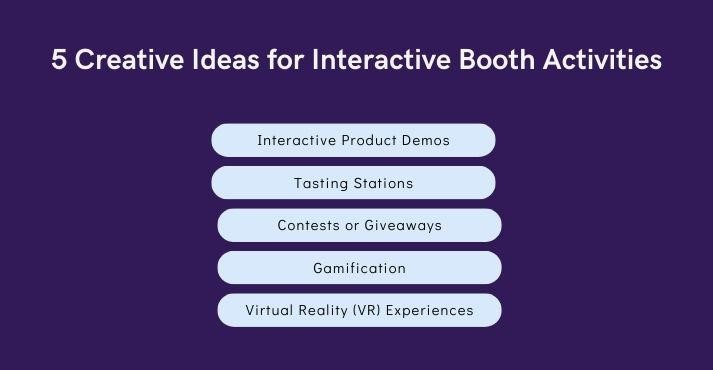Trade shows have always been a powerful marketing tool in the hospitality industry.
It provides invaluable opportunities for businesses to get in front of potential customers, strengthen relationships, generate leads, and close deals.
Becoming part of a tradeshow requires substantial investment, which is why maximizing the return on investment from the marketing efforts at the trade show is imperative.
It involves creating a customized booth design, preparing promotional materials and giveaways, and training staff members to interact with potential customers.
Moreover, with so many exhibitors competing for attention at a hospitality event, a well-thought-out trade show marketing strategy is needed to maximize ROI and drive success.
In this blog, we will explore how to build an effective trade show marketing strategy to ensure you’re fully prepared for success.
Setting Clear Tradeshow Objectives

First and foremost, the purpose of exhibiting at hospitality trade shows must be determined.
Ask yourself questions like:
- Are you looking to generate leads?
- Increase brand awareness?
- Launch a new product?
Defining objectives will guide your strategies and help you measure tradeshow marketing effectiveness, maximizing its impact. Clear goals provide direction and focus, guiding the team toward measurable outcomes.
For example, rather than having a vague goal, set quantifiable targets such as generating 100 qualified leads, increasing brand awareness by 20%, or achieving a 15% increase in sales conversions. Also, your business goals must align with trade show goals to maximize outcomes.
Here are some additional tips for establishing clear objectives:
1. Align with Business Goals
Ensure that your objectives align with the business goals. For example, if the business aims to expand into a new market segment, set lead generation goals targeting prospects.
2. Establish Key Performance Indicators (KPIs)
Identify relevant KPIs to track progress towards each objective. Here are some of the most common trade show KPIs include:
- Number of Leads Generated
- Booth Traffic
- Qualified Leads Percentage
- Sales Conversion Rate
- Brand Impressions
- Trade Show ROI
Moreover, brand awareness can be measured through website traffic, social media engagement, or survey responses.
3. Set Realistic Targets
Ensure your objectives are realistic and achievable within the context of the hospitality trade show. Consider factors such as the size of the event, the audience demographics, and the resources available for marketing and sales efforts.
4. Time-Bound Goals
Establish a timeline for achieving your objectives, taking into account the duration of the trade show and the post-event follow-up period. It will help you create a sense of urgency and ensure accountability for meeting targets.
5. Continuous Evaluation
Regularly monitor progress towards your objectives throughout the trade show and adjust strategies to optimize results.
Pre-Show Planning and Preparation
Most of the work involved in trade shows happens during the pre-show planning phase. You should spend months (not weeks) planning a trade show.
Before your event, ensure everything is in place and that it will run smoothly. As a first step, you must outline your goals and plan your event strategy.
Research and Select the Right Trade Shows
Research and choose hospitality trade shows that align with your target audience and industry relevance.
Choosing the right trade shows maximizes exposure to potential customers, enhances networking opportunities with industry peers, and increases the chances of achieving business objectives. It will help you optimize trade show marketing efforts and generate a higher return on investment.
Factors to evaluate when choosing a trade show for your business:
- Location: Assess proximity to target markets, accessibility, and venue reputation to ensure convenience for attendees and maximize visibility and foot traffic to the booth.
- Size: Evaluate the scale of the event relative to business objectives, balancing larger expos for broader exposure with smaller events for more focused networking opportunities.
- Exhibitor Opportunities: Research the quality of exhibitors to understand the potential networking and partnership opportunities.
Pro Tip: Attend trade shows as a visitor before exhibiting to gain insights into the event and its suitability for your business. This will determine your success in future participation.
Here are vital tips that should guide your decision:
- Audience Demographics: Research past attendee profiles and demographics to ensure alignment with your target market, increasing meaningful interactions and lead generation.
- Industry Trends: Analyze trade show themes, seminar topics, and exhibitor profiles to understand the relevance of current industry trends and innovations.
- Business Objectives: Align trade show goals with broader business objectives, such as brand exposure, lead generation, or product launches, to maximize the impact and relevance of your participation.
Target Audience Research

Research the demographic of the attendees and evaluate whether the audience aligns with your target market to ensure you maximize the potential for quality leads. You can also develop marketing materials that are more likely to resonate with them.
Researching your target audience for a specific hospitality trade show involves the following steps:
- Review Event Materials: Study promotional materials, attendee lists, and past event data to gain insights into the demographics of previous attendees.
- Utilize Social Media: Use social media platforms to explore discussions, groups, and hashtags related to the trade show.
- Conduct Surveys or Interviews: Reach out to existing customers or contacts who may have attended similar trade shows.
- Analyze Competitor Presence: Examine the exhibitor list to identify competitors and potential collaborators.
- Attend Pre-Event Activities: Participate in pre-event webinars, networking sessions, or forums organized by the trade show.
- Use Online Tools: Utilize online tools and databases to gather demographic information about the industry sector targeted by the trade show.
Develop a Comprehensive Marketing Plan
A trade show marketing plan provides a roadmap for aligning trade show objectives with broader marketing and business goals. You need to analyze marketing ideas for trade shows and create an outline for pre-show, during-show, and post-show activities.
Here’s a step-by-step process for creating a detailed trade show event marketing plan:
- Conduct Market Research: Gather insights on industry trends, competitor presence, and attendee demographics to inform strategic decisions.
- Identify Target Audience: Identify potential attendees’ specific demographics, interests, and pain points to tailor messaging and engagement strategies.
- Develop Messaging and Branding: Craft compelling messaging and visuals that communicate your value proposition and brand identity to resonate with the target audience.
- Plan Pre-Show Promotion: Create a comprehensive strategy to generate excitement and awareness about your participation through various channels.
- Prepare Sales and Marketing Collaterals: Prepare materials such as brochures, flyers, presentations, and samples that communicate your products or services, showcase your brand, and support your sales efforts.
- Execute During-Show Activities: Engage attendees through presentations, demonstrations, and networking to maximize brand exposure and lead generation.
- Implement Post-Show Follow-Up Strategy: Reach out to leads and contacts gathered during the trade show, nurturing relationships through personalized follow-up emails, calls, or meetings to engage prospects further and move them through the sales funnel.
- Analyze Results: Evaluate the outcomes by analyzing metrics such as lead generation, sales conversions, and return on investment, identifying successes and areas for improvement, and informing future trade show strategies.
Design an Engaging Booth

Achieving a standout exhibition booth design is not solely about drawing eyes but creating an immersive experience that effectively communicates the brand message.
Designing an eye-catching trade show booth requires careful planning, attention to detail, and focusing on your business objectives and target audience.
Follow these best practices for designing a visually appealing booth:
- Ensure your booth displays your company’s logo, name, and tagline.
- Use consistent brand colors and fonts to create a cohesive visual identity.
- Communicate your products or services with concise messaging that grabs attention and communicates value.
- Use high-quality graphics, images, and videos that are visually appealing and relevant to your brand and offerings.
- To stand out, incorporate eye-catching design elements such as bold colors, dynamic layouts, and creative signage.
- Utilize technology like digital displays or interactive presentations to captivate and educate visitors.
- Design the layout of your booth to encourage visitors to enter and explore.
- Create clear pathways and zones for product demonstrations, meetings, or interactive experiences.
- Offer interactive elements or hands-on demonstrations that allow visitors to engage with your products or services.
- Encourage social sharing by incorporating a social media photo booth.
Pro Tip: While grander booth constructs may be enticing, they should be evaluated against available resources and possible return on investment.
Maximizing Engagement During the Show
It’s time to maximize engagement and drive ROI.
Greet potential customers as they approach your booth. Have a well-designed, eye-catching display consistent with your brand identity.
Make sure your staff is well-informed and prepared to answer questions. Engage visitors through personalized interactions that address their needs and interests.
Train and Equip Booth Staff
Training and equipping booth staff is essential to maximize engagement during the show. Proper training ensures they understand the business offerings, communicate effectively with visitors, and handle inquiries professionally.
Properly trained staff can engage attendees in meaningful conversations, creating a positive and memorable experience for potential customers.
Trained staff can effectively qualify leads by asking relevant questions, understanding attendee needs, and identifying potential prospects more likely to convert into customers.
Moreover, trained booth staff contribute to a higher return on investment (ROI) as they can drive more qualified leads by maximizing engagement.
Interactive Booth Activities

Here are some creative ideas for interactive booth activities to encourage engagement and lead generation:
- Interactive Product Demos: Offer live demonstrations and deliver firsthand experience to educate and engage visitors.
- Tasting Stations: Set up tasting stations featuring a variety of samples or mini portions of your menu items or food products to create interest.
- Contests or Giveaways: Host contests or raffles to attract visitors and capture leads through entry forms or digital platforms.
- Gamification: Create a game where attendees match ingredients or create dishes using your products or equipment.
- Virtual Reality (VR) Experiences: Provide immersive VR experiences related to your products or industry, allowing attendees to explore virtual environments or interact with simulated scenarios.
Leverage Social Media and Digital Marketing
Trade show advertising via social media enhances visibility, engagement, and reach. It enables real-time interaction, promotes pre-event anticipation, and extends post-event engagement.
Whereas digital marketing maximizes exposure, facilitates lead generation, and builds lasting connections with a broader audience beyond the physical event space.
Consider these ways to amplify event promotion via social media and digital marketing:
- Live streaming demonstrations and behind-the-scenes.
- Utilizing event hashtags for increased visibility.
- Running targeted ads to reach relevant audiences.
- Engaging with attendees through interactive polls and Q&A sessions.
- Set up a designated area within your booth for live streaming.
- Conduct interviews with industry experts, satisfied customers, or key team members.
- Share the live stream link on your social media platforms and event page.
- Sharing post-event highlights and testimonials to maintain momentum.
Before the event, create buzz by sharing teasers, behind-the-scenes glimpses, and announcements on platforms like Twitter, Instagram, and Facebook.
Encourage attendees to share their experiences using event hashtags and geotags while running targeted ads and email campaigns to reach broader audiences.
Post-event, continue the conversation by sharing highlights, testimonials, and follow-up content to maintain momentum and ongoing engagement.
Post-Show Follow-Up and Evaluation
The work doesn’t end after the hospitality trade show.
Remember to follow up with all the leads and prospects after the show. Thank them for taking an interest in your brand, and use nurturing tactics to guide them through your sales funnel.
Define Your KPIs

Following up with prospects meaningfully is the top priority, but first, you must track the key metrics. KPIs are measurable, objective metrics for evaluating success.
Event KPIs are tailored to the type of event, the event size and budget, the data available, and the event goals. Measure the number of leads collected during the event. This could include contacts gathered at your booth, business cards exchanged, or sign-ups for newsletters or demos.
Here are some key hospitality KPIs to track for measuring trade show success
- Website Traffic: Monitor the increase in website traffic during and after the trade show. Use tools like Google Analytics to track the number of visitors, page views, and time spent on the site.
- Social Media Engagement: Track engagement metrics on social media platforms such as likes, shares, comments, and mentions related to the trade show. Monitor the reach and impressions of your posts, as well as any increase in followers or engagement rates compared to your usual metrics.
- Sales and Revenue: Track the number of deals closed or conversions attributed to leads generated at the event. Calculate the return on investment (ROI) by comparing the revenue generated to the cost of participating in the hospitality trade show.
- Brand Awareness: Assess the trade show’s impact on brand visibility and recognition. Monitor metrics like brand mentions, media coverage, and sentiment analysis to gauge your brand’s perception before and after the event.
Nurture and Qualify Leads
Timely follow-up and lead nurturing are essential to capitalize on hospitality trade show opportunities and maintain momentum. They keep your brand fresh in their minds and encourage continued engagement.
Moreover, timely follow-up helps leads retain interest and optimize return on investment. It presents a chance to personalize interactions and address specific needs discussed during the event.
Here are some critical tips for personalized follow-up communications to nurture quality leads:
- Personalized Email Campaigns
For personalized email campaigns, tailor messages based on interactions at the trade show, referencing specific discussions or interests.
Use segmentation to send targeted content that resonates with each recipient’s needs and preferences, encouraging further engagement.
- One-on-One Calls
When making phone calls, reference the hospitality trade show encounter and personalize the conversation by recalling critical points discussed.
Listen actively to the prospect’s needs and offer tailored solutions or next steps based on their interests.
- LinkedIn Connections
Send personalized connection requests referencing your meeting at the trade show for LinkedIn connections.
Follow up with a message highlighting shared interests or mutual connections and express interest in continuing the conversation.
Be genuine and add value to their network by sharing relevant content or insights related to your discussion at the event.
Analyze Results to Improve in the Future
Post-event analysis is the key to continuous improvement in event planning. It provides valuable insights into the effectiveness of your efforts, allowing you to identify strengths, weaknesses, and areas for improvement.
Benefits of post-event analysis:
- Performance Evaluation: Assess the event’s success and whether it met its objectives.
- Learning from Mistakes: Identify and learn from errors or shortcomings to avoid them in the future.
- Improved Planning: Refine event planning and execution processes for more efficient events.
- Enhanced Participant Experience: Use feedback to enhance attendee experiences and meet expectations.
- Resource Optimisation: Optimise resource allocation and budgeting for greater efficiency.
- Strategic Decision-Making: Inform strategic decisions, measure ROI, and adapt for long-term success.
Collecting and analyzing quantitative and qualitative data is essential for practical post-event analysis. By examining metrics such as lead generation, conversion rates, engagement levels, and return on investment, you can understand what worked well and what didn’t.
These insights enable you to make data-driven decisions and adjustments to your strategy, optimizing resource allocation and maximizing results.
For example, if specific tactics or messaging resonated strongly with attendees, you can replicate and use them in future events. Conversely, you can adjust or eliminate certain aspects to enhance effectiveness if they are underperformed.
Conclusion
Investing in marketing efforts for the hospitality trade show you’re participating in is important to driving positive ROI. This investment has the potential to nurture your sales opportunities and amplify your brand’s visibility.
Building an effective trade show marketing strategy requires careful planning, clear objectives, and continuous refinement.
By focusing on pre-show preparation, engaging booth design, targeted promotions, and personalized follow-up, businesses can maximize their impact at trade shows and capitalize on valuable insights for lead generation.
Additionally, leveraging technology and data analytics allows for more informed decision-making and the ability to measure and analyze the success of your efforts.
Most importantly, success at hospitality trade shows is determined not solely by the event but post-show activities, such as timely follow-up and lead nurturing.
Moreover, a thriving hospitality trade show marketing strategy integrates both pre-show planning and post-show evaluation, focusing on delivering value to attendees and achieving measurable results.
Participation in trade shows can yield substantial rewards for your business if strategized and executed correctly.








